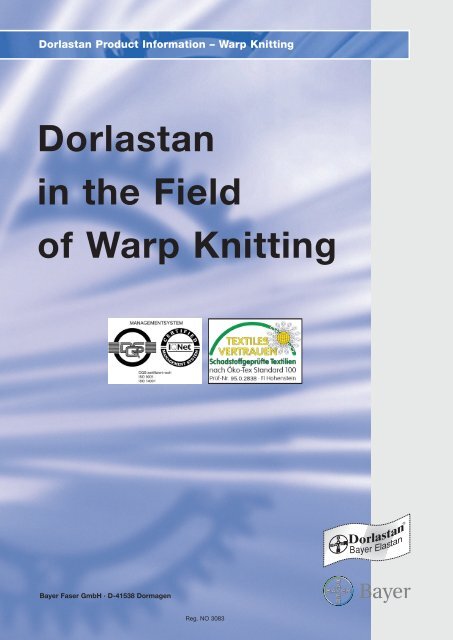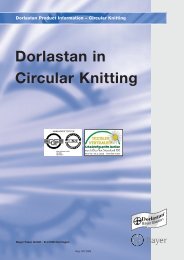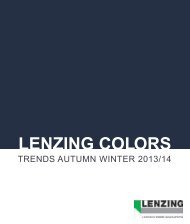Dorlastan in the Field of Warp Knitting - Fashion Trendsetter
Dorlastan in the Field of Warp Knitting - Fashion Trendsetter
Dorlastan in the Field of Warp Knitting - Fashion Trendsetter
- No tags were found...
You also want an ePaper? Increase the reach of your titles
YUMPU automatically turns print PDFs into web optimized ePapers that Google loves.
<strong>Dorlastan</strong> Product Information – <strong>Warp</strong> Knitt<strong>in</strong>g<strong>Dorlastan</strong><strong>in</strong> <strong>the</strong> <strong>Field</strong><strong>of</strong> <strong>Warp</strong> Knitt<strong>in</strong>gBayer Faser GmbH · D-41538 DormagenReg. NO 3083
<strong>Dorlastan</strong> Product Information – <strong>Warp</strong> Knitt<strong>in</strong>gContentsPage1. The <strong>Warp</strong><strong>in</strong>g Process 31.1 Creel<strong>in</strong>g <strong>of</strong> <strong>the</strong> <strong>Dorlastan</strong> Bobb<strong>in</strong>s 31.2 <strong>Warp</strong><strong>in</strong>g Elongation 41.3 Travers<strong>in</strong>g <strong>of</strong> <strong>the</strong> Reed 41.4 Adjust<strong>in</strong>g <strong>the</strong> <strong>Warp</strong><strong>in</strong>g Lengths <strong>of</strong> <strong>the</strong> <strong>Warp</strong> Sets or Creel Loads 42. <strong>Dorlastan</strong> <strong>in</strong> <strong>the</strong> field <strong>of</strong> <strong>Warp</strong> Knitt<strong>in</strong>g 62.1 <strong>Dorlastan</strong> on Raschel Knitt<strong>in</strong>g Mach<strong>in</strong>es 62.1.1 The Construction <strong>of</strong> Various Standard Power Nets 62.1.2 The Influence <strong>of</strong> <strong>Dorlastan</strong> on <strong>the</strong> Extensibility<strong>of</strong> <strong>the</strong> Power Net 72.1.3 The Influence <strong>of</strong> Polyamide on <strong>the</strong> Stretch Properties<strong>of</strong> Power Net 82.2 <strong>Dorlastan</strong> on Tricot Mach<strong>in</strong>es 102.2.1 Recommendations for <strong>the</strong> knitt<strong>in</strong>g <strong>of</strong> an elastic locknit fabricon an automatic warp knitt<strong>in</strong>g mach<strong>in</strong>e with a fabricwidth <strong>of</strong> 130" and a warp<strong>in</strong>g elongation <strong>of</strong> 40 – 50%. 11Published by and responsibilitygez. ppa. ZehrtBF <strong>Dorlastan</strong> Market<strong>in</strong>gCustomer ServiceApprovalgez. ppa. NahlBF Management <strong>Dorlastan</strong> Market<strong>in</strong>gEdition: 01: 07/94 02: 09/98 03: 01/04 04: 05: 06:2
<strong>Dorlastan</strong> Product Information – <strong>Warp</strong> Knitt<strong>in</strong>g1. The <strong>Warp</strong><strong>in</strong>g ProcessTo process <strong>Dorlastan</strong> on warp knitt<strong>in</strong>g or raschel mach<strong>in</strong>es, <strong>the</strong> material on <strong>the</strong>bobb<strong>in</strong>s must be warped, i.e. sectional beams must be prepared. For this purpose,<strong>the</strong>re are special warp<strong>in</strong>g mach<strong>in</strong>es for elastane yarns.1.1 Creel<strong>in</strong>g <strong>of</strong> <strong>the</strong> <strong>Dorlastan</strong> Bobb<strong>in</strong>sIf <strong>the</strong> bobb<strong>in</strong>s are not stored <strong>in</strong> a room climate correspond<strong>in</strong>g to that <strong>of</strong> <strong>the</strong>warp<strong>in</strong>g room, it is recommendable to unpack <strong>the</strong> yarn 24 hours before warp<strong>in</strong>gand leave it stand<strong>in</strong>g near <strong>the</strong> warp<strong>in</strong>g mach<strong>in</strong>e so that it can acclimatize. Thetemperature <strong>in</strong> <strong>the</strong> warp<strong>in</strong>g room should be 20–22°C at a relative humidity <strong>of</strong>60–65%.The bobb<strong>in</strong>s must be unpacked carefully so that <strong>the</strong> upper yarn layers do notslip to ensure that <strong>the</strong>y unw<strong>in</strong>d properly later. For this reason, <strong>the</strong> outer yarnlayers should not be touched.The creel should be loaded <strong>in</strong> such a way that yarns from bobb<strong>in</strong>s <strong>of</strong> <strong>the</strong> samebox are not situated next to each o<strong>the</strong>r <strong>in</strong> <strong>the</strong> yarn sheet <strong>of</strong> <strong>the</strong> sectional beam.Below you f<strong>in</strong>d an example for creels with 8 tiers:If threads from <strong>the</strong> vertical rows <strong>of</strong> bobb<strong>in</strong> holders lie next to each o<strong>the</strong>r <strong>in</strong> <strong>the</strong>yarn sheet <strong>of</strong> <strong>the</strong> sectional beam:bobb<strong>in</strong>s from <strong>the</strong> 1st box should be <strong>in</strong>stalled <strong>in</strong> <strong>the</strong> horizontal rows 1 + 5bobb<strong>in</strong>s from <strong>the</strong> 2nd box should be <strong>in</strong>stalled <strong>in</strong> <strong>the</strong> horizontal rows 2 + 6bobb<strong>in</strong>s from <strong>the</strong> 3rd box should be <strong>in</strong>stalled <strong>in</strong> <strong>the</strong> horizontal rows 3 + 7bobb<strong>in</strong>s from <strong>the</strong> 4th box should be <strong>in</strong>stalled <strong>in</strong> <strong>the</strong> horizontal rows 4 + 8 etc.If threads from <strong>the</strong> horizontal rows <strong>of</strong> bobb<strong>in</strong> holders lie next to each o<strong>the</strong>r <strong>in</strong> <strong>the</strong>yarn sheet <strong>of</strong> <strong>the</strong> sectional beam:bobb<strong>in</strong>s from <strong>the</strong> 1st box should be <strong>in</strong>stalled <strong>in</strong> <strong>the</strong> vertical rows 1, 5, 9, etc.bobb<strong>in</strong>s from <strong>the</strong> 2nd box should be <strong>in</strong>stalled <strong>in</strong> <strong>the</strong> vertical rows 2, 6, 10, etc.bobb<strong>in</strong>s from <strong>the</strong> 3rd box should be <strong>in</strong>stalled <strong>in</strong> <strong>the</strong> vertical rows 3, 7, 11, etc.bobb<strong>in</strong>s from <strong>the</strong> 4th box should be <strong>in</strong>stalled <strong>in</strong> <strong>the</strong> vertical rows 4, 8, 12, etc.3
<strong>Dorlastan</strong> Product Information – <strong>Warp</strong> Knitt<strong>in</strong>g1.2 <strong>Warp</strong><strong>in</strong>g ElongationThe usual f<strong>in</strong>al elongation <strong>of</strong> <strong>Dorlastan</strong> raschel qualities ranges between 25–50%,and that <strong>of</strong> <strong>Dorlastan</strong> tricot qualities between 40–50%.The optimum prelim<strong>in</strong>ary draft depends on <strong>the</strong> design <strong>of</strong> <strong>the</strong> particular warp<strong>in</strong>gmach<strong>in</strong>e as well as <strong>of</strong> <strong>the</strong> yarn package conditions and must be selectedaccord<strong>in</strong>gly.For a f<strong>in</strong>al elongation <strong>of</strong> 25%, use a prelim<strong>in</strong>ary draft <strong>of</strong> 70–120%.For a f<strong>in</strong>al elongation <strong>of</strong> 50%, use a prelim<strong>in</strong>ary draft <strong>of</strong> 100–150%.In <strong>the</strong> case <strong>of</strong> warp<strong>in</strong>g mach<strong>in</strong>es where no prelim<strong>in</strong>ary draft is applied,<strong>the</strong> standard f<strong>in</strong>al warp<strong>in</strong>g elongation is 40–50%.Modern warpers are able to control yarn tension. This means same yarn tensionresp. stretch <strong>of</strong> every sectional beam is guaranteed, <strong>in</strong>dependent <strong>of</strong> <strong>the</strong> fact, thatwith<strong>in</strong> <strong>the</strong> spools yarn tension is different. But this requires a constant roomtemperature <strong>of</strong> +/- 3° because yarn force depends also <strong>of</strong> <strong>the</strong> temperature.1.3 Travers<strong>in</strong>g <strong>the</strong> ReedIn order to obta<strong>in</strong> a uniform wound surface without groove formations,let <strong>the</strong> reed traverse 1–1 1 ⁄ 2 needle spaces.1.4 Adjust<strong>in</strong>g <strong>the</strong> <strong>Warp</strong><strong>in</strong>g Lengths <strong>of</strong> <strong>the</strong> <strong>Warp</strong>Set/Creel LoadsThe useful yarn length (runn<strong>in</strong>g length) per bobb<strong>in</strong> is <strong>in</strong>dicated <strong>in</strong> <strong>the</strong> dispatchdata <strong>of</strong> <strong>the</strong> batch. The lengths given <strong>the</strong>re are creel meters.Calculation = useful length – safety allowance = meters per sectional beamnumber <strong>of</strong> sectional beamsOw<strong>in</strong>g to possible differences between warp<strong>in</strong>g mach<strong>in</strong>es, figures result<strong>in</strong>g fromthis calculation should be regarded only as guide values for trials <strong>in</strong> <strong>the</strong> owncompany. The optimum warp<strong>in</strong>g lengths should be determ<strong>in</strong>ed by <strong>the</strong> customerhimself, based on <strong>the</strong> characteristics <strong>of</strong> his warp<strong>in</strong>g mach<strong>in</strong>e. The follow<strong>in</strong>gyardages that account for approximately 1% <strong>of</strong> <strong>the</strong> useful yarn length must betaken <strong>in</strong>to consideration:• Waste meters required to thread up <strong>the</strong> warper and get uniform elongationdur<strong>in</strong>g startup• Waste required to start up each additional section beam• Small amount left <strong>in</strong> <strong>the</strong> creel on <strong>the</strong> bobb<strong>in</strong>s (waste yarn)4
<strong>Dorlastan</strong> Product Information – <strong>Warp</strong> Knitt<strong>in</strong>gThe sectional beams belong<strong>in</strong>g to one warp set must always be warped at <strong>the</strong>same speed.For example: The first sectional beam <strong>of</strong> a warp set is warped accord<strong>in</strong>g to <strong>the</strong>calculated creel yardage for <strong>the</strong> sectional beam and <strong>the</strong> speed isread <strong>of</strong>f. The rema<strong>in</strong><strong>in</strong>g sectional beams <strong>of</strong> <strong>the</strong> warp set are <strong>the</strong>nwarped at <strong>the</strong> same speed as <strong>the</strong> first sectional beam.After that, <strong>the</strong> warp set is put toge<strong>the</strong>r <strong>in</strong> <strong>the</strong> same sequence as<strong>the</strong> warped sectional beam.A warp set should never be made up from sectional beams <strong>of</strong> different creelloads (sets) unless it is possible to put toge<strong>the</strong>r <strong>the</strong> same sectional beams from<strong>the</strong> same bobb<strong>in</strong> layer <strong>of</strong> <strong>the</strong> creel loads.For example: 5 sets <strong>of</strong> bobb<strong>in</strong>s are available and it is <strong>in</strong>tended to make warpsets with 5 sectional beams. The basic prerequisites are identicalspeeds <strong>of</strong> <strong>the</strong> sectional beams (SB), identical elongation and identicalbobb<strong>in</strong> sets (creel loads).Set <strong>of</strong> bobb<strong>in</strong>s 1 2 3 4 51st warp set = 1 SB 1SB 1SB 1SB 1SB = outer layer <strong>of</strong> <strong>the</strong>bobb<strong>in</strong>s2nd warp set = 1 SB 1SB 1SB 1SB 1SB = <strong>in</strong>termediate layer <strong>of</strong> <strong>the</strong>bobb<strong>in</strong>s3rd warp set = 1SB 1SB 1SB 1SB 1SB = <strong>in</strong>ner layer <strong>of</strong> <strong>the</strong>bobb<strong>in</strong>setc. depend<strong>in</strong>g on <strong>the</strong> length <strong>of</strong> <strong>the</strong> sectional beams and <strong>the</strong> bobb<strong>in</strong>s.5
<strong>Dorlastan</strong> Product Information – <strong>Warp</strong> Knitt<strong>in</strong>g2. <strong>Dorlastan</strong> <strong>in</strong> <strong>the</strong> <strong>Field</strong> <strong>of</strong> <strong>Warp</strong> Knitt<strong>in</strong>gBy far <strong>the</strong> largest share <strong>of</strong> <strong>Dorlastan</strong> is processed as bare <strong>Dorlastan</strong> on automaticwarp knitt<strong>in</strong>g mach<strong>in</strong>es or raschel knitt<strong>in</strong>g mach<strong>in</strong>es for <strong>the</strong> important applicationfields <strong>of</strong> corsetry and sportswear. As to warp knitt<strong>in</strong>g, <strong>Dorlastan</strong> is particularlysuited for <strong>the</strong> production <strong>of</strong> elastic power nets, elastic tapes and tightlyconstructed elastic fabrics. The tulle constructions are ma<strong>in</strong>ly used formanufactur<strong>in</strong>g cosetry. For sportswear ma<strong>in</strong>ly <strong>the</strong> tightly constructed elasticfabrics are used. Table 1 gives an overview <strong>of</strong> <strong>the</strong> possible applications <strong>of</strong><strong>Dorlastan</strong> <strong>in</strong> <strong>the</strong> fields <strong>of</strong> warp knitt<strong>in</strong>g and raschel knitt<strong>in</strong>g.<strong>Field</strong> <strong>of</strong> application Characteristics <strong>Dorlastan</strong><strong>of</strong> <strong>the</strong> fabrictiter (dtex)L<strong>in</strong>gerie Comfort stretch 17–45smooth elasticitySwimwear Comfort stretch 45–80Leisure wear, sportswear Comfort stretch 33–80Corsetry-type underwear Good stretch properties 80Corsetry High retractive force 160–480Tapes High retractive force 320–960Table 1: Possible applications <strong>in</strong> <strong>the</strong> fields <strong>of</strong> warp knitt<strong>in</strong>g and raschelknitt<strong>in</strong>gIn warp knitt<strong>in</strong>g, one <strong>of</strong> <strong>the</strong> basic pr<strong>in</strong>ciples must be to prevent <strong>the</strong> elastic threadfrom com<strong>in</strong>g <strong>in</strong>to contact with mach<strong>in</strong>e parts as far as possible. Major changes<strong>in</strong> <strong>the</strong> direction <strong>of</strong> <strong>the</strong> thread should be performed only by means <strong>of</strong> rotat<strong>in</strong>gguid<strong>in</strong>g devices or pulleys <strong>in</strong> order to avoid congestion and variations <strong>in</strong> <strong>the</strong>tension <strong>of</strong> <strong>the</strong> <strong>in</strong>dividual threads. For <strong>the</strong> manufacture <strong>of</strong> an elastic article and itsquality, <strong>the</strong> <strong>in</strong>terdependence <strong>of</strong> <strong>the</strong> mach<strong>in</strong>e gauge, <strong>the</strong> yarn count <strong>of</strong> <strong>the</strong> elasticmaterial and <strong>the</strong> yarn feed characteristics is <strong>of</strong> considerable importance.The most common mach<strong>in</strong>e gauges <strong>of</strong> 36 to 64 gg can be used for <strong>the</strong> <strong>Dorlastan</strong>titers 45 to 960 dtex, with <strong>the</strong> coarser mach<strong>in</strong>e gauges be<strong>in</strong>g used for <strong>the</strong> coarser<strong>Dorlastan</strong> titers and <strong>the</strong> f<strong>in</strong>er gauges for <strong>the</strong> f<strong>in</strong>er titers. Which mach<strong>in</strong>e andthread adjustments are most appropriate for <strong>the</strong> respective required quality canonly be determ<strong>in</strong>ed by prelim<strong>in</strong>ary trials.2.1 <strong>Dorlastan</strong> on Raschel Knitt<strong>in</strong>g Mach<strong>in</strong>es2.1.1 Construction <strong>of</strong> Various Standard Power NetsThe lapp<strong>in</strong>g movement <strong>of</strong> <strong>the</strong> <strong>Dorlastan</strong> threads and <strong>the</strong> polyamid threads canclearly be seen <strong>in</strong> <strong>the</strong> diagrams below (Figure 1 and 2). The various sett<strong>in</strong>gsdescribed, which have considerable <strong>in</strong>fluence on <strong>the</strong> properties <strong>of</strong> <strong>the</strong> power netcan be understood clearly us<strong>in</strong>g <strong>the</strong>se diagrams.6
<strong>Dorlastan</strong> Product Information – <strong>Warp</strong> Knitt<strong>in</strong>gRaschel net <strong>of</strong> <strong>Dorlastan</strong> ® and Polyamide8-mach<strong>in</strong>e rapport4 guide bars, thread<strong>in</strong>g: 1 full / 1 emptyguide bar 1fiber material Perlon filament yarntechnical notation cha<strong>in</strong> l<strong>in</strong>ks2Perlon filament yarntechnical notation cha<strong>in</strong> l<strong>in</strong>ks3<strong>Dorlastan</strong>technical notation cha<strong>in</strong> l<strong>in</strong>ks4<strong>Dorlastan</strong>technical notation cha<strong>in</strong> l<strong>in</strong>ksLG1 LG2LG3 LG410122123211223211210122111001 0 1 000113 2 1 03 2 1 0Figure 1: Raschel netFabric for corsetry and swimwear (sat<strong>in</strong>-stretch)guide barfiber material1 & 2Perlon filament yarntechnical notation cha<strong>in</strong> l<strong>in</strong>ks01102112guide bar 2 full thread<strong>in</strong>g2 guide bars:guide bar 3 full thread<strong>in</strong>gorfor all guide bars4 guide barsthread<strong>in</strong>g: half-set thread<strong>in</strong>g3 & 4Perlon filament yarntechnical notation cha<strong>in</strong> l<strong>in</strong>ks00110022Figure 2: Sat<strong>in</strong>-stretch3 2 1 0 3 2 1 02.1.2 The Influence <strong>of</strong> <strong>Dorlastan</strong> on <strong>the</strong> Extensibility <strong>of</strong><strong>the</strong> Power NetBy vary<strong>in</strong>g <strong>the</strong> tension <strong>of</strong> <strong>the</strong> <strong>Dorlastan</strong> while keep<strong>in</strong>g <strong>the</strong> polyamide feed ata constant rate it is possible to produce a fabric with high or low length stretch.If <strong>the</strong> <strong>Dorlastan</strong> thread is fed <strong>in</strong> with a particularly high tension, i.e. less <strong>Dorlastan</strong>is taken up per rack (unit <strong>of</strong> 480 courses), <strong>the</strong> stitch count <strong>of</strong> <strong>the</strong> greige goods<strong>in</strong>creases.7
<strong>Dorlastan</strong> Product Information – <strong>Warp</strong> Knitt<strong>in</strong>gThe compacted fabric <strong>the</strong>n provides a high longitud<strong>in</strong>al stretch while <strong>the</strong> widthstretch <strong>of</strong> <strong>the</strong> net is low due to <strong>the</strong> <strong>in</strong>creased tension <strong>of</strong> <strong>the</strong> <strong>Dorlastan</strong> thread.Fur<strong>the</strong>rmore, <strong>the</strong> greige width is only slightly narrower compared with <strong>the</strong>work<strong>in</strong>g width, though heavier <strong>in</strong> weight per m 2 .The power net has low length stretch, if <strong>the</strong> <strong>Dorlastan</strong> is fed <strong>in</strong> with low threadtension, i.e. more elastic material is taken up per rack. In this case, <strong>the</strong> netstructure is less compacted by <strong>the</strong> <strong>Dorlastan</strong>. Compared with a fabric conta<strong>in</strong><strong>in</strong>g<strong>Dorlastan</strong> with high run-<strong>in</strong> tension, <strong>the</strong> greige goods contract more <strong>in</strong> <strong>the</strong> widthand become lighter <strong>in</strong> weight per m 2 . With this sett<strong>in</strong>g, <strong>the</strong> length stretch is lowerwhile <strong>the</strong> width stretch <strong>in</strong>creases slightly.2.1.3 The Influence <strong>of</strong> Polyamide on <strong>the</strong> Stretch Properties<strong>of</strong> Power Net.Ano<strong>the</strong>r factor that has considerable <strong>in</strong>fluence on <strong>the</strong> stretch <strong>of</strong> a fabric is <strong>the</strong>amount <strong>of</strong> polyamide thread taken up per rack. A higher run-<strong>in</strong> leads to a moreopen net structure with <strong>the</strong> correspond<strong>in</strong>g higher length and width stretch. Thefabric width <strong>in</strong>creases.An article <strong>of</strong> corsetry produced with a considerably reduced polyamide feed hasa tight loop structure that provides for little stretch <strong>in</strong> <strong>the</strong> length and widthdirection. The fabric width decreases.In practice, keep<strong>in</strong>g <strong>the</strong> above factors <strong>in</strong> m<strong>in</strong>d, adjustments to <strong>Dorlastan</strong> andpolyamide feed rates, as well as o<strong>the</strong>r mach<strong>in</strong>e sett<strong>in</strong>gs are used to product <strong>the</strong>specific power net quality desired. The most important characteristics withregard to <strong>the</strong> fabric structure are <strong>the</strong> length and width stretch, <strong>the</strong> percentage <strong>of</strong><strong>Dorlastan</strong>, uniformity <strong>of</strong> appearance, <strong>the</strong> fabric weight and width. It is <strong>the</strong>properties <strong>of</strong> <strong>the</strong> f<strong>in</strong>ished fabric that determ<strong>in</strong>es when and if production istaken up.Table 2 shows a list <strong>of</strong> <strong>the</strong> most common yarn counts, Figure 3 gives an examplefor process<strong>in</strong>g (power net)Mach<strong>in</strong>e gauge Polyamide <strong>Dorlastan</strong> Fabric(needles per <strong>in</strong>ch) (dtex) (dtex) qualitiesE 18 44– 78 160–320 Tec-net67–119 320–960 tec-net andstandard power netE 20 78–133 480–800 Standard power netE 24 56–110 400–800 Standard power netE 28 44– 78 45–320 Standard power netand locknitE 32 33– 56 33–160 Standard power netand locknitTable 2: The most common yarn titers8
<strong>Dorlastan</strong> Product Information – <strong>Warp</strong> Knitt<strong>in</strong>gTechnical data: Power net quality: Standard power net, 6-course-rapport polyamideMach<strong>in</strong>e type: elastic raschel (Mayer) Fiber material: 78 dtex f 18 (70/18 den)Mach<strong>in</strong>e gauge 48 gg <strong>Dorlastan</strong> 560 dtex (490 den)Work<strong>in</strong>g width: 100" = 2540 mm Thread<strong>in</strong>g: Guide bars 1 + 2: Perlon, 1 full / 1 emptyWork<strong>in</strong>g speed: 800 T/m<strong>in</strong> per guide bar 1200 threadsGuide bars 3 + 4: <strong>Dorlastan</strong>, 1 full / 1 emptyper guide bar 1,200 threadsPerlon take-up ratio: 110 cm / rack<strong>Dorlastan</strong> take-up ratio: 8,5 cm / rack<strong>Dorlastan</strong> warp: 50 % extensionFabric structure Needle Fabric width Courses / Fabric contraction <strong>in</strong> Weight per m 2wales/cm (cm) cm Longitud<strong>in</strong>al direction (cm) (g)Gray cloth under tension 10,0 253,5 42,0 100 –on <strong>the</strong> loom(take-up tension))Relaxed gray cloth 11,3 221,0 72,0 57,5 –(laid out for 24 h)Relaxed gray cloth 14,2 165,5 82,7 51,2 297,4(hot water treatment)F<strong>in</strong>ished goods:– Polyamide <strong>in</strong>corporated <strong>in</strong> 10 cm fabric: approx. 170 cm– <strong>Dorlastan</strong> titer <strong>in</strong> <strong>the</strong> non-extended fabric: 437 dtex– <strong>Dorlastan</strong> snapback from 10 cm non-extended fabric: 9.2 cm– Percentage by weight <strong>of</strong> <strong>Dorlastan</strong>: 22.6 %– Extensibility on apply<strong>in</strong>g a stress <strong>of</strong> 0.5 kp/cm on specimen:Width <strong>of</strong> specimen: Longitud<strong>in</strong>al direction: 124%, Transverse direction: 54.7%F<strong>in</strong>ished goods 12,7 190,5 76,0 55,7 241,0Extensibility <strong>of</strong> <strong>the</strong> f<strong>in</strong>ished good <strong>in</strong> longitud<strong>in</strong>al direction 125 % at a specimen load 5 N/cmExtensibility <strong>of</strong> <strong>the</strong> f<strong>in</strong>ished good <strong>in</strong> transverse direction 55 % at a specimen load 5 N/cmFigure 3: Power net9
<strong>Dorlastan</strong> Product Information – <strong>Warp</strong> Knitt<strong>in</strong>g2.2 <strong>Dorlastan</strong> on Tricot Mach<strong>in</strong>esBecause <strong>of</strong> <strong>the</strong>ir f<strong>in</strong>e mach<strong>in</strong>e gauges“ E 28 up to E 40, tricot mach<strong>in</strong>es areappropriate for <strong>the</strong> use <strong>of</strong> <strong>the</strong> <strong>Dorlastan</strong> titers 17 to 80 dtex. They are processed<strong>in</strong>to tightly constructed, f<strong>in</strong>e elastic fibers on <strong>the</strong>se mach<strong>in</strong>es. Most <strong>of</strong> <strong>the</strong> articlesare produced with two guide bars, one <strong>of</strong> <strong>the</strong>m be<strong>in</strong>g threaded with <strong>Dorlastan</strong>.<strong>Dorlastan</strong> can be warp-knitted with <strong>the</strong> lapp<strong>in</strong>g movements produc<strong>in</strong>g jerseystitch, sat<strong>in</strong> stitch and comb<strong>in</strong>ations <strong>of</strong> <strong>the</strong>se. It is, however, better to replace<strong>the</strong> tension bars commonly used on tricot mach<strong>in</strong>es by matt chromium-platedguid<strong>in</strong>g elements, e.g. rollers, for <strong>the</strong> elastic warp.Where rotat<strong>in</strong>g tension rollers are <strong>in</strong>stalled as guid<strong>in</strong>g devices it must be ensuredby all means that no imbalance occurs <strong>in</strong> <strong>the</strong>ir runn<strong>in</strong>g motion. Due to <strong>the</strong> highyarn consumption <strong>of</strong> <strong>the</strong> loop-form<strong>in</strong>g elastic material, high tension builds up <strong>in</strong><strong>the</strong> yarn between clear<strong>in</strong>g and cast<strong>in</strong>g-<strong>of</strong>f. If <strong>the</strong> tension roller is not runn<strong>in</strong>gevenly, <strong>the</strong>se forces will become evident <strong>in</strong> <strong>the</strong> gray and <strong>the</strong> f<strong>in</strong>ished fabric asstripes repeated at short <strong>in</strong>tervals.The f<strong>in</strong>e <strong>Dorlastan</strong> titers 17 to 80 dtex that are wound on <strong>the</strong> sectional beam witha warp<strong>in</strong>g elongation <strong>of</strong> 40 to 50% should be treated with great care when <strong>the</strong>mach<strong>in</strong>e is adjusted to <strong>the</strong> respective article. Improper handl<strong>in</strong>g can lead to yarnbreakage which - particularly as <strong>the</strong> thread<strong>in</strong>g <strong>of</strong> broken ends is more difficul<strong>the</strong>re than e.g. with polyamide yarns - will <strong>of</strong>ten result <strong>in</strong> <strong>in</strong>terruptions <strong>of</strong> <strong>the</strong>production process.The possibilities <strong>of</strong> work<strong>in</strong>g with very high tensions <strong>of</strong> <strong>the</strong> <strong>Dorlastan</strong> thread arelimited due to <strong>the</strong> fact that <strong>the</strong> stra<strong>in</strong> on <strong>the</strong> needles due to <strong>the</strong> force <strong>of</strong> fabrictake-down may be too high (<strong>the</strong> threads fed <strong>in</strong> form an angle <strong>of</strong> about 90° with<strong>the</strong> knitted fabric taken <strong>of</strong>f) and this will lead to manufactur<strong>in</strong>g problems.The raschel mach<strong>in</strong>e permits higher thread tension and higher take-<strong>of</strong>f forces.Here, <strong>the</strong> thread material fed <strong>in</strong> and <strong>the</strong> f<strong>in</strong>ished fabric taken <strong>of</strong>f form an angle <strong>of</strong>about 180°.For quality control purposes and to determ<strong>in</strong>e <strong>the</strong> f<strong>in</strong>al sett<strong>in</strong>gs <strong>of</strong> an elasticarticle construction, <strong>the</strong> amount <strong>of</strong> yarn consumed is recorded <strong>in</strong> centimeters perrack (480 courses). The percentage <strong>of</strong> <strong>Dorlastan</strong> <strong>in</strong> a particular fabric can beregulated by <strong>the</strong> knitt<strong>in</strong>g construction to vary between 10% and 40% for a s<strong>in</strong>gletiter comb<strong>in</strong>ation.10
<strong>Dorlastan</strong> Product Information – <strong>Warp</strong> Knitt<strong>in</strong>g2.2.1 Recommendations for <strong>the</strong> warp knitt<strong>in</strong>g <strong>of</strong> an elasticlocknit fabric on a 28 gg warp knitt<strong>in</strong>g mach<strong>in</strong>e witha work<strong>in</strong>g width <strong>of</strong> 130“ and a warp<strong>in</strong>g elongation<strong>of</strong> 40 to 50%.Fabrics with this pla<strong>in</strong> tricot weave are most commonly produced <strong>in</strong> <strong>the</strong> follow<strong>in</strong>gtiter comb<strong>in</strong>ations:Guide bar 1 Guide bar 2a) 45 dtex <strong>Dorlastan</strong> 44 dtex polyamideb) 45 dtex <strong>Dorlastan</strong> 33 dtex polyamidec) 45 dtex <strong>Dorlastan</strong> 22 dtex polyamided) 80 dtex <strong>Dorlastan</strong> 44 dtex polyamidee) 80 dtex <strong>Dorlastan</strong> 67 dtex polyamideDepend<strong>in</strong>g on <strong>the</strong> material comb<strong>in</strong>ation selected, <strong>the</strong> percentage <strong>of</strong> <strong>Dorlastan</strong> <strong>in</strong><strong>the</strong> f<strong>in</strong>ished article ranges between 18 and 37%.The number <strong>of</strong> courses per centimeter is set on <strong>the</strong> mach<strong>in</strong>e to about 20 coursesand contracts <strong>in</strong> <strong>the</strong> relaxed fabric to 38 to 44 courses per centimeter. The graywidth shr<strong>in</strong>ks from <strong>the</strong> full work<strong>in</strong>g width <strong>of</strong> <strong>the</strong> automatic warp knitt<strong>in</strong>g mach<strong>in</strong>eto approx. 150 cm. The predeterm<strong>in</strong>ed length <strong>of</strong> thread fed <strong>in</strong> per 480 courses isfixed <strong>in</strong> accordance with <strong>the</strong> desired elongation at50 to 65 cm for <strong>the</strong> <strong>Dorlastan</strong> warp and142 to 164 cm for polyamide warp.The good runn<strong>in</strong>g properties <strong>of</strong> <strong>the</strong> elastic material allow full utilization <strong>of</strong> <strong>the</strong>mach<strong>in</strong>e capacity.F<strong>in</strong>ished locknit fabrics provide good length and width stretch (see table 7).The weight per m 2 <strong>of</strong> comb<strong>in</strong>ations with low titers can be adjusted atapproximately 130g and that <strong>of</strong> comb<strong>in</strong>ations with higher titers at up to 250g.Figure 4 shows <strong>the</strong> technical notation <strong>of</strong> a locknit fabric.Elastic locknit fabric on automatic warp knitt<strong>in</strong>g mach<strong>in</strong>e28 gg.2 guide barsGuide barFiber material1<strong>Dorlastan</strong>Technical notation Cha<strong>in</strong> l<strong>in</strong>ks1011212Perlon filament yarnTechnical notationCha<strong>in</strong> l<strong>in</strong>ks2321012 1 03 2 1 0Figure 4: Technical notation <strong>of</strong> a locknit fabric11
<strong>Dorlastan</strong> Product Information – <strong>Warp</strong> Knitt<strong>in</strong>gA locknit fabric conta<strong>in</strong><strong>in</strong>g elastic material will always have a slightly unsteady look<strong>in</strong> <strong>the</strong> warp direction. By modify<strong>in</strong>g <strong>the</strong> polyamide lapp<strong>in</strong>g, e.g. to <strong>the</strong> so-called twilllapp<strong>in</strong>g, this unsteady appearance can be avoided. The elongation propertieschange slightly (see table 3).LocknitTwillapp<strong>in</strong>gWeight per m 2 Courses/ Needle wales/ Length Widthg cm cm stretch % stretch %133 64 27,6 250 105173 44,5 24,1 210 105191 54 23,5 150 75232 38 22,8 180 115187 64 25,8 180 75228 33,5 22,7 100 100256 55 21,8 45 70Table3: Longitud<strong>in</strong>al and transverse extensibility with locknitor twill lapp<strong>in</strong>gIf, <strong>in</strong> a particular fabric, stretch is required only <strong>in</strong> one direction, e.g. length stretch,this can be achieved by modify<strong>in</strong>g <strong>the</strong> knitt<strong>in</strong>g technique, i.e. by chang<strong>in</strong>g from <strong>the</strong>counter lapp<strong>in</strong>g to <strong>the</strong> cloth-tricot lapp<strong>in</strong>g.The above mentioned examples show only a few possibilities <strong>of</strong> produc<strong>in</strong>g tightlyconstructed elastic fabrics. <strong>Warp</strong> knitt<strong>in</strong>g provides for many solutions <strong>in</strong> this sector.Table 4 shows <strong>the</strong> technical data for a few examples <strong>of</strong> locknit fabrics produced on130“ automatic warp knitt<strong>in</strong>g mach<strong>in</strong>es.In <strong>the</strong> case <strong>of</strong> elastic fabrics from automatic warp knitt<strong>in</strong>g mach<strong>in</strong>es it is particularlyrecommended that <strong>the</strong> greige fabric be wound with surface drive rolls.Polyamid <strong>Dorlastan</strong> <strong>Dorlastan</strong> Yarn feed <strong>Dorlastan</strong> Courses/cm Weight Width<strong>Warp</strong><strong>in</strong>g per m 2 <strong>of</strong> <strong>the</strong> <strong>of</strong> <strong>the</strong>Titer Titer elongation cm/rack Percentage Fabric f<strong>in</strong>ished f<strong>in</strong>ished(dtex) (dtex) (%) <strong>Dorlastan</strong> polyamide (%) Gray F<strong>in</strong>ished fabric (g) fabric (g)22 45 50 44 132 31 34 64 133 8344 45 50 51 130 21 44 54 191 10067 45 50 60 160 15 20 38 232 102Table 4: Technical data for locknit fabricsNoteIf you have any questions concern<strong>in</strong>g <strong>the</strong> field <strong>of</strong> warp knitt<strong>in</strong>g please do no<strong>the</strong>sitate to contact our department Market<strong>in</strong>g <strong>Dorlastan</strong>:Dormagen, Germany Tel. +49 21 33 / 51-50 85Bushy Park/USA Tel. +1 84 38 20-65 1012







